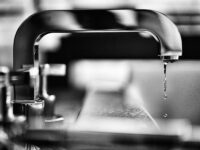The following contribution is from another author.
Looking after a home costs a lot of money. Things go wrong all the time, draining your pocketbook and making you feel poor.
The trick here is to protect your home so that things don’t break or go wrong in the first place. But what exactly should you be doing?
Clean Out Your Furnace Filter
After a long winter, your furnace filter will become impregnated with particles. If it becomes clogged, it will not only increase your energy bills, but will also damage the furnace itself, making it more likely that you will need to replace it at some point in the future. Be sure to clean it out regularly – at least once per year.
Inspect Sink Drains
You’ll also want to regularly inspect your tub and sink drains. Doing this is important because it prevents water from spilling up over the sides of your baths and sinks and onto the floor. It allows the emergency drainage hole to work as it should if you accidentally leave a faucet running, preventing water damage to your home.
Inspect Electrical Cords For Wear
Worn electrical cords are downright dangerous. While the wires themselves will last indefinitely, the plastic surrounding fatigues over time, increasing the likelihood of fire under load. Replace electrical cords with fresh ones where possible.
Vacuum Your Heat Vents
Heat vents can attract dust from your rooms which accumulates over time. Be sure to vacuum them regularly to remove any debris that could damage your heating system.
Bleed Your Radiators
Over time, radiators can fill with air. When this happens, it prevents the central heating from working properly, encouraging you to crank up the thermostat higher and higher. Doing this then puts more pressure on the boiler, making it work overtime. These practices could substantially shorten it’s life.
Tint Your Windows
Most people use residential window tinting to protect their skin from harmful UV rays. But it turns out that these short wavelengths of light can also damage home furnishings. Light rays break down organic compounds in wood, paint and upholstery, making it appear bleached or faded. The simplest and most affordable solution is to simply apply a layer of tint to your windows.
Winterize Your Plumbing
Winter can be a trying time for plumbing systems. When water freezes in downspouts and outdoor pipes, it can expand, causing them to crack. To winterize outdoor pipes, provide them with plenty of insulation. If necessary, set up aftermarket heating solutions to eliminate ice formation.
Clean Your Carpets Regularly
Most carpets degrade over time. But in many cases, it is unnecessary. Usually, it stems from a lack of regular cleaning.
Carpets break down primarily because of fine particles that become incorporated into their structure. These create abrasive action which wears down the fibres, causing them to become damaged. Cleaning your carpet, therefore, is a great way to prevent this from happening. Vacuum once per week and then use deep cleaning tools every three to six months.
Replace Damaged Siding
Occasionally, your home’s siding will become damaged – usually because of storms. Don’t leave problems to fester. If you ignore siding issues, your home could develop damp and high winds may lead to further damage to surrounding materials.
Replacing siding is easy. Just call up a local contractor who knows how to deal with it and get them to fix it. It should only take half a day at most.
Vacuum Gutters
Vacuuming gutters is another essential preventative maintenance technique every homeowner needs in their arsenal. Debris can cause overflowing gutters and downpipes, leading to pools of water that can cause damp around the base of your home.
If you can’t get a vacuum up to your gutters, then just use your hands to scoop out any debris blocking the watercourse.
Clean Your Refrigerator Coils
Some refrigerators and freezers build coils into the interior of the unit, so you don’t need to clean these. Most models, however, don’t, so you’ll need to vacuum all the dust and debris yourself.
Doing this is critical because it allows your equipment to function efficiently. If you don’t regularly vacuum, then the compressor in your unit has to work harder, shortening its life.
Seal Your Grout
Grouting doesn’t last forever. Eventually it begins to crack and break down, providing opportunities for mold and water to infiltrate. Avoid this problem by regularly regrouting your bathrooms. If you notice black streaks in your grouting, switch to a product that actively prevents mold growth. Deal with cracks in grout around tiles rapidly to prevent further damage.
















